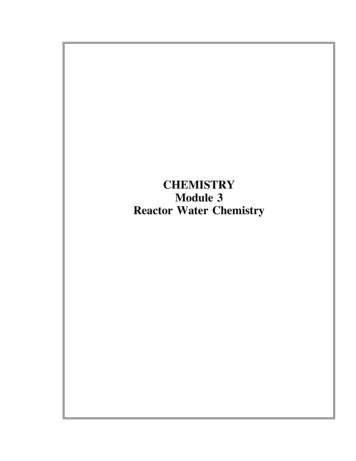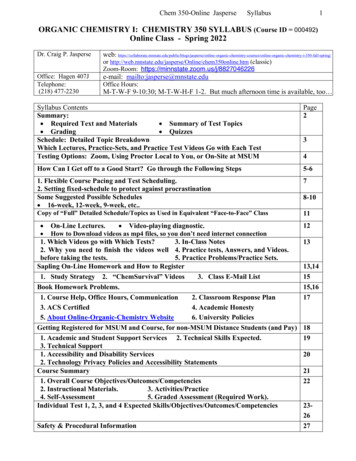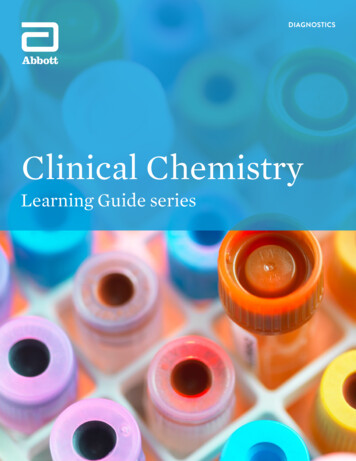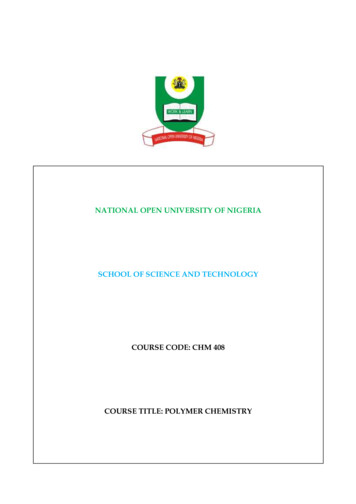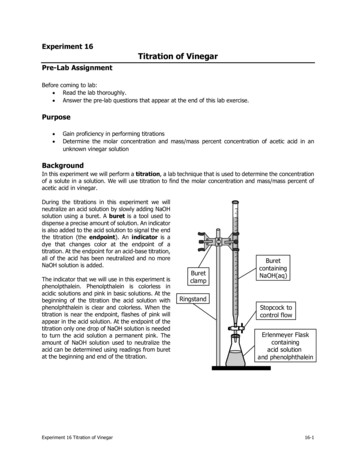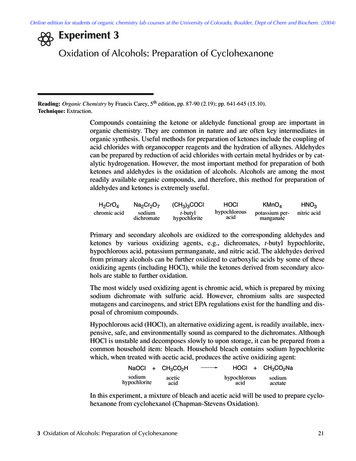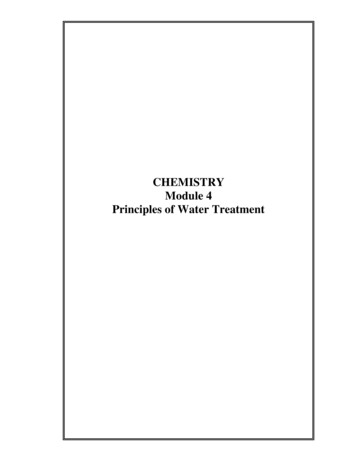
Transcription
Department of EnergyFundamentals HandbookCHEMISTRYModule 4Principles of Water Treatment
Principles of Water TreatmentDOE-HDBK-1015/2-93TABLE OF CONTENTSTABLE OF CONTENTSLIST OF FIGURES . . . . . . . . . . . . . . . . . . . . . . . . . . . . . . . . . . . . . . . . . . . . . . . . . . . . . iiLIST OF TABLES . . . . . . . . . . . . . . . . . . . . . . . . . . . . . . . . . . . . . . . . . . . . . . . . . . . . . . iiiREFERENCES . . . . . . . . . . . . . . . . . . . . . . . . . . . . . . . . . . . . . . . . . . . . . . . . . . . . . . . . ivOBJECTIVES . . . . . . . . . . . . . . . . . . . . . . . . . . . . . . . . . . . . . . . . . . . . . . . . . . . . . . . . . vPURPOSE OF WATER TREATMENT . . . . . . . . . . . . . . . . . . . . . . . . . . . . . . . . . . . . . 1Water Treatment . . . . . . . . . . . . . . . . . . . . . . . . . . . . . . . . . . . . . . . . . . . . . . . . . 1Summary . . . . . . . . . . . . . . . . . . . . . . . . . . . . . . . . . . . . . . . . . . . . . . . . . . . . . . . 2WATER TREATMENT PROCESSES . . . . . . . . . . . . . . . . . . . . . . . . . . . . . . . . . . . . . . 3Principles of Ion Exchange . . . . . . . . . . . . . . . . . . . . . . . . . . . . . . . . . . . . . . . . . . 3Specific Ion Exchanger Reactions . . . . . . . . . . . . . . . . . . . . . . . . . . . . . . . . . . . . 11Summary . . . . . . . . . . . . . . . . . . . . . . . . . . . . . . . . . . . . . . . . . . . . . . . . . . . . . . 13DISSOLVED GASES, SUSPENDED SOLIDS,AND pH CONTROL . . . . . . . . . . . . . . . . . . . . . . . . . . . . . . . . . . . . . . . . . . . . . . . . . . . 15Removal of Dissolved Gases . . . . . . . . . . . . . . . . . . . . . . . . . . . . . . . . . . . . . . . .Removal of Suspended Solids . . . . . . . . . . . . . . . . . . . . . . . . . . . . . . . . . . . . . . .pH Control . . . . . . . . . . . . . . . . . . . . . . . . . . . . . . . . . . . . . . . . . . . . . . . . . . . . .Resin Bed Malfunctions . . . . . . . . . . . . . . . . . . . . . . . . . . . . . . . . . . . . . . . . . . .Summary . . . . . . . . . . . . . . . . . . . . . . . . . . . . . . . . . . . . . . . . . . . . . . . . . . . . . .1520212226WATER PURITY . . . . . . . . . . . . . . . . . . . . . . . . . . . . . . . . . . . . . . . . . . . . . . . . . . . . . 28Water Purity . . . . . . . . . . . . . . . . . . . . . . . . . . . . . . . . . . . . . . . . . . . . . . . . . . . . 28Summary . . . . . . . . . . . . . . . . . . . . . . . . . . . . . . . . . . . . . . . . . . . . . . . . . . . . . . 30Rev. 0Page iCH-04
TABLE OF CONTENTSDOE-HDBK-1015/2-93Principles of Water TreatmentLIST OF FIGURESFigure 1 Polymerization of Cross-Linked Polystyrene Resins . . . . . . . . . . . . . . . . . . . . . . 5Figure 2 Production of Anion and Cation Forms of Cross-LinkedPolystyrene Ion Exchange Resins . . . . . . . . . . . . . . . . . . . . . . . . . . . . . . . . . . . 6Figure 3 Schematic Diagram of a Typical Ion Exchanger . . . . . . . . . . . . . . . . . . . . . . . . . 8Figure 4 Typical History Curve . . . . . . . . . . . . . . . . . . . . . . . . . . . . . . . . . . . . . . . . . . . 11Figure 5 A Typical Pretreatment System . . . . . . . . . . . . . . . . . . . . . . . . . . . . . . . . . . . . 16Figure 6 Behavior of Hydrogen Form Cation Exchange Bed as itRemoves Ammonium Ions From Solution . . . . . . . . . . . . . . . . . . . . . . . . . . . 23CH-04Page iiRev. 0
Principles of Water TreatmentDOE-HDBK-1015/2-93LIST OF TABLESLIST OF TABLESTable 1 Typical Ionized Impurities in Water . . . . . . . . . . . . . . . . . . . . . . . . . . . . . . . . . . 2Table 2 Properties of Ion Exchange Resins . . . . . . . . . . . . . . . . . . . . . . . . . . . . . . . . . . . 9Table 3 Water Purity . . . . . . . . . . . . . . . . . . . . . . . . . . . . . . . . . . . . . . . . . . . . . . . . . . . 28Rev. 0Page iiiCH-04
REFERENCESDOE-HDBK-1015/2-93Principles of Water TreatmentREFERENCESDonald H. Andrews and Richard J. Kokes, Fundamental Chemistry, John Wiley & Sons,Inc., 1963Compressed Gas Association, Inc., Handbook of Compressed Gases, 2nd Edition,Reinhold Publishing Corporation, 1981.R. A. Day, Jr. and R. C. Johnson, General Chemistry, Prentice Hall, Inc., 1974.Dickerson, Gray, Darensbourg and Darensbourg, Chemical Principles, 4th Edition, TheBenjamin Cummings Publishing Company, 1984.Academic Program for Nuclear Plant Personnel, Volume II, Chemistry, Columbia, MD,General Physics Corporation, Library of Congress Card #A 326517, 1972.General Physics Corporation, Fundamentals of Chemistry, General Physics Corporation,1982.Glasstone and Sesonske, Nuclear Reactor Engineering, 3rd Edition, Van NostrandReinhold Company, 1981.McElroy, Accident Prevention Manual for Industrial Operations Engineering andTechnology, Volume 2, 8th Edition, National Safety Council, 1980.Sienko and Plane, Chemical Principles and Properties, 2nd Edition, McGraw and Hill,1974.Underwood, Chemistry for Colleges and Schools, 2nd Edition, Edward Arnold, Ltd.,1967.Norman V. Steere and Associates, CRC Handbook of Laboratory Safety, 2nd Edition,CRC Press, Inc., 1971.CH-04Page ivRev. 0
Principles of Water TreatmentDOE-HDBK-1015/2-93OBJECTIVESTERMINAL OBJECTIVE1.0Without references, EXPLAIN the concept and application of ion exchange in waterpurification.ENABLING OBJECTIVES1.1LIST the three reasons for removing impurities from water prior to use in reactorsystems.1.2DEFINE the following terms:a.b.c.d.1.3e.f.g.h.PolymerMixed-bed demineralizerAffinityDecontamination factorDESCRIBE the following:a.b.c.1.4Ion exchangeDemineralizeCationAnionResin beadCation resinAnion resinDISCUSS the following factors of ion exchange:a.b.Relative affinityDecontamination factor1.5WRITE the reaction for removal of NaCl and CaSO4 by a mixed-bed ion exchanger suchas one containing HOH resin.1.6EXPLAIN the three basic methods used to remove dissolved gases from water.1.7LIST five filtration mediums used to remove suspended solids from water.1.8EXPLAIN how mixed-bed ion exchangers may be used to control pH.Rev. 0Page vCH-04
OBJECTIVESDOE-HDBK-1015/2-93Principles of Water TreatmentENABLING OBJECTIVES (Cont.)1.9DISCUSS resin malfunctions, including the austionLIST the maximum conductivity and approximate concentration of electrolyte for eachlevel of purity for makeup water.Page viRev. 0
Principles of Water TreatmentDOE-HDBK-1015/2-93PURPOSE OF WATER TREATMENTPURPOSE OF WATER TREATMENTWater normally contains many impurities, among which are trace minerals andchemicals. The need for removing these impurities is discussed in this chapter.EO 1.1LIST the three reasons for removing impurities from waterprior to use in reactor systems.Water TreatmentWater treatment is necessary to remove the impurities that are contained in water as found innature. Control or elimination of these impurities is necessary to combat corrosion, scaleformation, and fouling of heat transfer surfaces throughout the reactor facility and supportsystems.The following are three reasons for using very pure water in reactor facility systems.Rev. 01.To minimize corrosion, which is enhanced by impurities.2.To minimize radiation levels in a reactor facility. Some of the natural impuritiesand most of the corrosion products become highly radioactive after exposureto the neutron flux in the core region. If not removed, these soluble andinsoluble substances may be carried to all parts of the system.3.To minimize fouling of heat transfer surfaces. Corrosion products and otherimpurities may deposit on core surfaces and other heat transfer regions, whichresult in decreased heat transfer capabilities by fouling surfaces or blockage ofcritical flow channels. Areas of high concentrations of these impurities andcorrosion products may also lead to extreme conditions of the various corrosionprocesses with resultant failure of components or systems.Page 1CH-04
PURPOSE OF WATER TREATMENTDOE-HDBK-1015/2-93Principles of Water TreatmentThere are several processes used in reactor facilities to purify the water in the systems andwater used as makeup. Deaeration is used to strip dissolved gases, filtration is effective in theremoval of insoluble solid impurities, and ion exchange removes undesirable ions and replacesthem with acceptable ions. Typical ionized impurities found in water are shown in Table 1.TABLE 1Typical Ionized Impurities in WaterCationsAnionsCa NO3-Mg OH-Na SO4--K Cl-Al HCO3-Fe HSiO3-Cu HCrO3-SummaryThe important information in this chapter is summarized below.Purpose of Water Treatment SummaryThere are three general reasons to treat water for its impurities:CH-041.To minimize corrosion, which is enhanced by impurities2.To minimize radiation levels in the reactor facility3.To minimize fouling of heat transfer surfacesPage 2Rev. 0
Principles of Water TreatmentDOE-HDBK-1015/2-93WATER TREATMENT PROCESSESWATER TREATMENT PROCESSESOne of the more common water treatment methods is the use of demineralizersand ion exchange. This method will be discussed in this chapter.EO 1.2DEFINE the following terms:a.b.c.d.EO 1.3PolymerMixed-bed demineralizerAffinityDecontamination factorResin beadCation resinAnion resinDISCUSS the following factors of ion exchange:a.b.EO 1.5e.f.g.h.DESCRIBE the following:a.b.c.EO 1.4Ion exchangeDemineralizeCationAnionRelative affinityDecontamination factorWRITE the reaction for removal of NaCl and CaSO4 by amixed-bed ion exchanger such as one containing HOH resin.Principles of Ion ExchangeIon exchange is a process used extensively in nuclear facilities to control the purity and pH ofwater by removing undesirable ions and replacing them with acceptable ones. Specifically, it isthe exchange of ions between a solid substance (called a resin) and an aqueous solution (reactorcoolant or makeup water). Depending on the identity of the ions that a resin releases to thewater, the process may result in purification of water or in control of the concentration of aparticular ion in a solution. An ion exchange is the reversible exchange of ions between a liquidand a solid. This process is generally used to remove undesirable ions from a liquid andsubstitute acceptable ions from the solid (resin).The devices in which ion exchange occurs are commonly called demineralizers. This name isderived from the term demineralize, which means the process whereby impurities present in theincoming fluid (water) are removed by exchanging impure ions with H and OH- ions, resultingin the formation of pure water. H and OH- are present on the sites of resin beads contained inthe demineralizer tank or column.Rev. 0Page 3CH-04
WATER TREATMENT PROCESSESDOE-HDBK-1015/2-93Principles of Water TreatmentThere are two general types of ion exchange resins: those that exchange positive ions, calledcation resins, and those that exchange negative ions, called anion resins. A cation is an ion witha positive charge. Common cations include Ca , Mg , Fe , and H . A cation resin is one thatexchanges positive ions. An anion is an ion with a negative charge. Common anions includeCl-, SO4--, and OH-. An anion resin is one that exchanges negative ions. Chemically, both typesare similar and belong to a group of compounds called polymers, which are extremely largemolecules that are formed by the combination of many molecules of one or two compounds ina repeating structure that produces long chains.A mixed-bed demineralizer is a vessel, usually with a volume of several cubic feet, that containsthe resin. Physically, ion exchange resins are formed in the shape of very small beads, calledresin beads, with an average diameter of about 0.005 millimeters. Wet resin has the appearanceof damp, transparent, amber sand and is insoluble in water, acids, and bases. Retention elementsor other suitable devices in the top and bottom have openings smaller than the diameter of theresin beads. The resin itself is a uniform mixture of cation and anion resins in a specific volumeratio depending on their specific gravities. The ratio is normally 2 parts cation resin to 3 partsanion resin.In some cases, there may be chemical bonds formed between individual chain molecules atvarious points along the chain. Such polymers are said to be cross-linked. This type of polymerconstitutes the basic structure of ion exchange resins. In particular, cross-linked polystyrene isthe polymer commonly used in ion exchange resins. However, chemical treatment of polystyreneis required to give it ion exchange capability, and this treatment varies depending on whether thefinal product is to be an anion resin or a cation resin.The chemical processes involved in producing anion and cation resins are outlined in Figure 1and Figure 2, beginning with the formation of cross-linked polystyrene. The polymer itself is acovalent compound. By the chemical reactions indicated in Figure 2, hydrogen atoms covalentlybonded to the original polymer at certain sites are replaced by functional groups (called radicals)such as SO3H (sulfonic acid) and CH2N(CH3)3Cl (quaternary ammonium). Each such group iscovalently bonded to the polymer, but each also contains an atom that is bonded to the radicalgroup by a predominantly ionic bond. In the two examples above, H in SO3H and Cl inCH2 N(CH3)3Cl are the ionically-bonded atoms. Sometimes these are written as SO3 - H andCH2N(CH3)3 Cl- to emphasize their ionic characters. These ions (H and Cl-) are replaceable byother ions. That is, H will exchange with other cations in a solution, and Cl- will exchange withother anions.In its final form, an ion exchange resin contains a huge, but finite, number of sites occupied byan exchangeable ion. All of the resin, except the exchangeable ion, is inert in the exchangeprocess. Thus, it is customary to use a notation such as R-Cl or H-R for ion exchange resins.R indicates the inert polymeric base structure and the part of the substituted radical that does notparticipate in exchange reactions. The term R is inex
water, the process may result in purification of water or in control of the concentration of a particular ion in a solution. An ion exchange is the reversible exchange of ions between a liquid and a solid. This process is generally used to remove undesirable ions from a liquid
